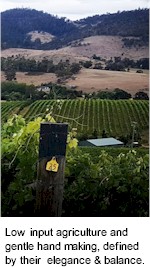About Clarence House - the Winery
Clarence House
Situated halfway between Hobart and Coal Valley, at the foothills of Meehan Ranges, the Clarence House landscapes were planted to vineyards in 1998
The first people to occupy the land were the local Moomairremener. European colonists farmed the Clarence district with cereal crops and established light grazing. The soils of Clarence Plains was particularly favourable, Reverend Robert Knopwood proclaiming in 1814 "a very delightful place, where they grew some of the finest wheat ever grown in Van Dieman's Land". The manors at Clarence House was built in the early 1830s by William Nichols, master builder and overseer of convicts. The house itself was built in two stages, whereas the adjoining stables began construction in 1826 and were not finished until 1928. Clarence House was sold at auction in 1844 following failed business ventures in windmills by William Nichol’s son. It eventually passed on to the Chipman family who remained farming the valley until Charles Chipman’s passing in 1955. Subsequent stewardship by the Tsamassiros family ended after a fire allegedly started by squatters in 1973. It was then restored by the Kline family, followed by the McGuigan and Newman families, until the property was acquired by the Kilpatricks in 1993.

The original stables are in near original condition and the house boasts a fascinating history, having been continually occupied since 1832, with detailed historical references, including a collection of diaries from the 1850s. The building itself is three storeys, sandstone construction, entered into the Register of National Estate and formally added to the Heritage Listing in 1998. It is an excellent example of early Georgian architecture, constructed from sandstone quarried on site, retaining many features, including the original bread oven and cellar. The main facades have been unaltered since photographs taken in the late 1800s. The land on which it stands is ideal for viticulture, auspicious dermosol soils from Jurassic dolerite and propitious strata of basalt with a highly opportune northeastern aspect.
Initially planted to just 6 hectares, the first vines included chardonnay, pinot noir, sauvignon blanc, tempranillo, merlot and cabernet sauvignon. Further expansion occurred, pushing the overall holdings to 13ha, with inclusion of more pinot noir and chardonnay, along with pinot blanc.
Pinot blanc was planted after consultation with former winemaker Andrew Hood, who suggested that the similarity between Oregon and local conditions would make for excellent pinot blanc. A further 3ha of pinot noir was planted, utilizing the last remaining appropriate land to cap the vineyard at 16 hectares.

Clarence House vineyard is planted to moderates slopes, rolling hills which face northeast, enjoying the benefits of early morning sun without the harsh impact of late afternoon heat. Harvests were initially sold until the vines reached maturity, when the Clarence House label was created in 2006. The vineyard now has three labels, Clarence Plains, Clarence House Estate and Clarence House Reserve. The Reserve wines are a selection of the best barrels from each vintage and will often result in extended oak maturation. The wines are made by a team of highly accomplished vignerons with many vintages of experience. A strict regimen of low input agriculture and gentle hand making, ensure that the wines are finished to an old world standard of sublime excellence, a superb range of wines defined by their elegance and balance. Pinot Noir clones include 114, 115, 667, 777, MV6, Abel, G5V15 2051, D5V12 (8048) and D4V2 Pommard.
The vineyard is managed conscientiously, with judicious use of inputs and sustainability in mind. Systemic herbicides, insecticides and fungicides are not used. The vineyard undervine area is slashed, the inter row sward is left to thrive and flower, irrigation is used sparingly and the vine canopies are treated in such a way as to promote balanced, tempered growth in line with the current season’s conditions. In doing so, the Clarence House fruit boasts beautiful aromatics, fresh natural acidity and physiologically ripe tannins.
